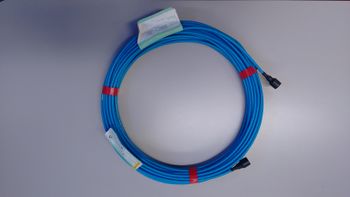Montrose coax: Difference between revisions
Thomastheo (talk | contribs) mNo edit summary |
(some more stats) |
||
| (3 intermediate revisions by one other user not shown) | |||
| Line 7: | Line 7: | ||
}} | }} | ||
One of our participants (gert) showed up with a load of old (but seemingly high quality) coaxial cable from a data center. There are other people online looking for info on | One of our participants (thanks gert!) showed up with a load of old (but seemingly high quality) coaxial cable from a data center. There are other people online looking for info on this very same coax, but so far nothing is out there to be found. In an effort to remedy that, here's what we managed to figure out for ourselves. | ||
The cable is marked as follows: | The cable is marked as follows: | ||
| Line 13: | Line 13: | ||
MONTROSE / CDT 16 AWG (UL) CL2P SHIELDED COAXIAL 125C CSA CXC 60C FT4 & FT6 | MONTROSE / CDT 16 AWG (UL) CL2P SHIELDED COAXIAL 125C CSA CXC 60C FT4 & FT6 | ||
It's 50 ohm coax, | It's 50 ohm coax, it has a braid/foil shielding, and a stranded center conductor. The velocity factor is 0.85, suggesting a foam polyethylene dielectric. The exterior is supposedly UV resistant. | ||
| Line 29: | Line 29: | ||
</gallery> | </gallery> | ||
== Further measurements == | |||
Attenuation/100 meters: | |||
@26MHz=1.33dB, | |||
@50MHz=1.81dB, | |||
@70MHz=1.99dB, | |||
@145MHz=3.35dB. | |||
Latest revision as of 19:41, 24 October 2018
| Project Montrose coax | |
|---|---|

| |
| Mystery coax specifications. | |
| Status | Completed |
| Contact | thomas |
| Last Update | 2018-10-24 |
One of our participants (thanks gert!) showed up with a load of old (but seemingly high quality) coaxial cable from a data center. There are other people online looking for info on this very same coax, but so far nothing is out there to be found. In an effort to remedy that, here's what we managed to figure out for ourselves.
The cable is marked as follows:
MONTROSE / CDT 16 AWG (UL) CL2P SHIELDED COAXIAL 125C CSA CXC 60C FT4 & FT6
It's 50 ohm coax, it has a braid/foil shielding, and a stranded center conductor. The velocity factor is 0.85, suggesting a foam polyethylene dielectric. The exterior is supposedly UV resistant.
Measurement
The velocity factor was measured with time domain reflectometry. I built a cheap and easy fast-rising-edge pulse generator after a design by Alan Wolke (W2AEW). See his video for details.
My version is a dip 74AC14 with all necessary components, connections and even an SMA connector soldered directly onto the chip. The 74AC14 offers six inverting schmitt triggers. The first one is used to invert an incoming signal, driving the remaining five schmitt triggers, which are ganged together and connected to the coax under test via the SMA. I'm just using a signal generator to provide the first schmitt trigger with a square wave, but you can implement Alan's solution of using the first Schmitt trigger in an oscillator with the addition of just a single resistor and capacitor.
Further measurements
Attenuation/100 meters: @26MHz=1.33dB, @50MHz=1.81dB, @70MHz=1.99dB, @145MHz=3.35dB.


